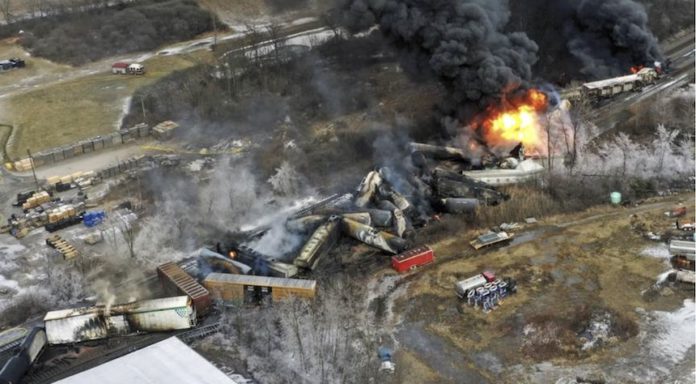Ohio Gov. Mike DeWine addressed the public on Tuesday, updating citizens and reporters about the tragic train derailment that occurred in E. Palestine (Ohio) on February 3. The derailment and controlled burning of hazardous chemicals that followed it have left the small town reeling.
The most shocking revelation from the press conference was the fact that the train was not considered to be carrying hazardous chemicals.
DeWine stated, “I learned today that this train wasn’t considered a high-hazard material train from the PUCO [Public Utilities Council of Ohio]”. The railroad did not have to inform anyone in Ohio about the contents of the train.
DeWine stated that even though some rail cars had hazardous material aboard, most did not. “That’s why it wasn’t categorized as high hazardous material train.” This is, frankly, absurd if true. We need to examine this. Congress must examine how these matters are handled. It is important that we know when trains are carrying hazardous materials through Ohio.” The governor asked Congress to investigate and amend the law as necessary.
DeWine pointed out that approximately 50 railroad cars were involved, ten of which were transporting hazardous materials. DeWine stated that the U.S. EPA and Ohio EPA arrived on the scene to stop the flow of contaminated waters while firefighters put out the flames. Two days later, “concerns began arising in regard to temperature in one car,” which he described as “volatile.” He activated the National Guard immediately.
He explained that the fear was that the car might explode and send deadly shrapnel all around. After speaking with the people on the ground, it became clear that there were two options. The first option was to wait for the car’s explosion. He was informed that there was a high probability of a catastrophic explosion, which would send shrapnel out nearly a mile. He said that he decided to proceed with the controlled release option. “We sent law enforcement back into those zones, which were the red and yellow zones, for the third time to knock on, literally knock at doors,” to evacuate residents. After “the monitoring showed the air was almost exactly as it was before the train crashed, which is what we expected it to be,” they were allowed to return home.
The press conference also contained other takeaways:
- Although it has been reported that there was little to no response to the wreck, the fact is that federal, state, and local authorities are providing a continuous, comprehensive response.
- Officials from the EPA are monitoring a chemical “plume”, which is moving toward the Ohio River at a speed of one mile per hour. Officials can shut down drinking water supplies until the chemical “plume” is eliminated. Tiffany Kavalee from the Division of Surface Water at the Ohio EPA stated that this strategy along with other drinking water treatment methods like oxidation or advanced…treatment like activated carbon are both effective in addressing these contaminants and help ensure safe drinking water. We are confident that the low levels of contaminants will not be passed on to customers.
- Bruce Vanderhoff is the Ohio Department of Health’s director. He said that the main concern right now is water quality, especially for those with private wells. Both those who have private wells and those who are on municipal water were urged to drink bottled water until further testing can be done. He also urged those who have private wells to contact the hotline to get their water tested for free. Residents are also offered bottled water. Vanderhoff stated that pregnant women and breastfeeding mothers could be particularly vulnerable.
- Kurt Kohler is the Ohio EPA’s emergency response coordinator. He said that they are focusing on several areas: Pleasant Road, where cars are still being staged; the wreckage area, where the cars are still being transported; and the area around Pleasant Road where chemicals have been spilled. Kohler also stated that the Ohio EPA’s emergency response team has “boots on the ground every day since the onset” of the incident and that it is safe to transfer to mediation.
- Today, the Ohio Department of National Resources announced that 3,500 dead fish including 12 species were found in streams, tributaries, and waterways throughout the state. There are no endangered fish among those 3,500 dead fish. Mary Mertz, Ohio Department of National Resources director, stated that wildlife officers have been “present every day on-scene, working with contractors, doing the net sampling and making estimates. We will continue to watch and monitor the situation and hold those responsible for wildlife loss in the region accountable.
- The waterways were tested last February 10. On February 10, 2010, the Ohio EPA’s website reported that the waterways had been tested for two contaminants. Butyl acrylate is low and ethyl hexyl acrylate is high. The report also shows no evidence of vinyl chloride in nearby waterways.
- Reporters were asked about the symptoms of headaches and sore throats in the community. Vanderhoff said, “It is an equation of duration over-concentration.” The greater the risk, the higher the concentration and the longer the duration. All evidence so far points to very low levels.” He advised those suffering symptoms to call their doctors and inform the hotline, “so that a team can check their environment.”
- DeWine answered questions about the federal government’s reaction to the crash. He stated that “the federal government is conducting an inquiry to determine why this wreck happened.”
- Bruce Baldridge (director of agriculture) answered a question regarding reports of livestock deaths in the region. His department has been in touch with the state veterinarian and area veterinarians, and they have told people to contact their local veterinarian if they notice signs of livestock disease. He said, “To the present day, there hasn’t been anything in the livestock community that could cause any concern for the state.”
- DeWine stated that Norfolk Southern had made a verbal promise to pay the derailment costs. “But, you understand, I understand people’s skepticism and I understand their anger. You should also know that if I lived in this community, I would be mad too. This problem is owned by the railroad. They will be held responsible.”
According to the governor, he has no evidence pointing at deliberate actions being the cause of the derailment.
It is clear that this situation remains extremely dangerous and that there are many unknowns. The residents are rightly concerned about the long-term health effects of being exposed to dangerous chemicals. It will be difficult to determine if the officials have done enough to reduce the risk.










